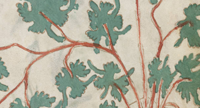❋ notice ❋
As of right now, there are no conlang grammars uploaded to this site. However, that doesn't mean I can't still use this as a lovely little landing page. You can still read some brief overviews, and some behind-the-scenes information, for now! I am working on finishing touches and formatting for Pholadzaw, which should be uploaded here soon.
❋ Pholadzaw - coming soon! ❋
Pholadzaw was spoken by one of the first, and largest, state-level societies in the Kerzo Gulf region. It's a pretty standard agglutinative language, with a distinction between aspirate, tenuis, and voiced stops.
Sample: Simi khats mawə lahokhə mezlendawga wə. "The herbs were stolen from our table."
❋ Jôkhap - coming soon!❋
Jôkhap is a Sukhenic language that became the major lingua franca of Eastern Tays before the Najmikaat. Grammatically, it's known for a distinction between "complex" and "simplex" verbs, with unique inflection styles for each, as well as heavy use of pivot structures.
Sample: Nunombe poceje kis côjih. "The large sow crushed his femur."
❋ Umehtukazu - coming soonish! ❋
Umehtukazu is a Seaboard-Samapi language spoken throughout the Land of Mahayat Rule. It is an attempt to make a triconsonantal root language, like the Semitic langs of Earth, that is distinctly not Semitic in sound, appearance, or deeper grammatical structure. It has a small consonant inventory and a standard 5-vowel set. Grammatically, it is very reliant on verbs, and has grammaticalized directional, transitivity, and intensity marking on verbs.
Sample: Zeyɣusenax isiʔonaxtuz ukekeznax motri. "I put two in the wooden box."
❋ Hokutonkunese - coming soonish! ❋
Spoken by a Chestnut culture, Hokutonkunese is one of the weirder langs I've developed. It has a unique system of syntactic alignment, where location is a mandatory element of all sentences, but verbs are not. In fact, locative markings are far and away the most grammatically necessary and productive part of the language - they can describe motion, possession, relation, absence, presence, contact, and more. Phonologically, it has a complex system of nasal harmony and floating tones, with only 9 consonant phonemes.
Sample: Hǫ́ǫndú mbápwí tsyòta tetwę̀, hokhú tǫ ndaap lyę́ khų́. "We have planted the seeds, so a village shall arise (here) in ten years."
❋ Meqvi - coming eventually! ❋
Meqvi, a Sukhenic language, best known as the language of the Najmikaat conquerors. It is a highly agglutinative language, with some light polysynthesis. Following the Najmikaat, many distinctive features faded; for example, it lost polysynthesis and its distinct male and female dialects.
❋ Hašǂi and Kǁhesaou - coming eventually! ❋
Click languages, of the Pǁya family. Notable for their unique ways of clause embedding and generally light morphology. Also, they're both attempts at making click languages that don't seem Khoisan or Bantu. Kǁhesaou has a very West European vowel system and a non-click consonant inventory more similar to Caucasian languages than Khoekhoe or !Xoo. Hašǂi allows clicks to cluster with other consonants or even be geminated, and has significantly fewer consonants (including clicks) than most Khoisan languages overall.
